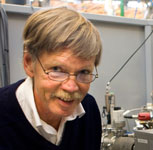The KTH Great Prize 2011 awarded to MAX-lab’s Mikael Eriksson
Professor Mikael Eriksson, a driving force behind the MAX-lab research laboratory in Lund is this year’s recipient of the KTH Great Prize. The laboratory conducts experiments considered by many to border on the impossible.

Announcing the selection of Professor Eriksson for the KTH Great Prize for 2011, KTH President Peter Gudmundson cited “his courage to think along new pathways and his grand vision in accelerator physics. He has played a key role as a designer of the internationally acclaimed MAX-lab at Lund University in southern Sweden.”
Max-lab’s full name is The National Electron Accelerator Laboratory for Synchrotron Radiation Research, Nuclear Physics and Accelerator Physics.
The synchrotron radiation research conducted by Eriksson and his team at Max-lab focusses on investigating the structure, properties and function of molecules and materials. “Max-lab conducts research that stretches the bounds of what is theoretically possible,” President Gudmundson said in the citation. The KTH Great Prize is accompanied by a grant of about SEK 1 million (USD 160,000).
Eriksson describes the early efforts of building a world-famous physics laboratory as surprisingly modest. “When we were working on the first technology to generate the light source, one of my colleagues brought in his mother’s old washing machine so we could jury-rig some transformer plates,” he says.
From its origins as a small university project in the 1970s, Max-lab has grown to become one of the world’s leading physics research centres. The laboratory’s combination of scientific excellence and start-of-the-art equipment attracts researchers from around the world in fields as diverse as physics, biology, chemistry, geology and archaeology.
The synchrotron radiation facility can be called a super microscope, with a light source derived from a circular accelerator that uses magnets to increase the momentum of electrons. The electrons are diverted to generate electromagnetic radiation with a variety of wavelengths, from infrared light to high-energy “hard” X-ray.
“MAX-lab made it possible for Swedish archaeologists to analyse the composition of berries and herbs contained in ink to see which county an old book was written in,” Eriksson says. “Other archaeologists brought their research to Lund to find the cause of deterioration in the wood of the 17th-century warship Vasa, one of Scandinavia’s largest tourist attractions. And we’ve had researchers in ozone layer depletion come to us to use the MAX-lab light source to mimic the sun.”
Eriksson says his innovative design solutions were partly inspired by his uncle, KTH Professor Hannes Alfvén, who received the 1970 Nobel Prize in Physics.
